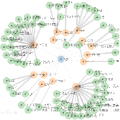Knowledge graph (KG) alignment and completion are usually treated as two independent tasks. While recent work has leveraged entity and relation alignments from multiple KGs, such as alignments between multilingual KGs with common entities and relations, a deeper understanding of the ways in which multilingual KG completion (MKGC) can aid the creation of multilingual KG alignments (MKGA) is still limited. Motivated by the observation that structural inconsistencies -- the main challenge for MKGA models -- can be mitigated through KG completion methods, we propose a novel model for jointly completing and aligning knowledge graphs. The proposed model combines two components that jointly accomplish KG completion and alignment. These two components employ relation-aware graph neural networks that we propose to encode multi-hop neighborhood structures into entity and relation representations. Moreover, we also propose (i) a structural inconsistency reduction mechanism to incorporate information from the completion into the alignment component, and (ii) an alignment seed enlargement and triple transferring mechanism to enlarge alignment seeds and transfer triples during KGs alignment. Extensive experiments on a public multilingual benchmark show that our proposed model outperforms existing competitive baselines, obtaining new state-of-the-art results on both MKGC and MKGA tasks.
翻译:知识图(KG)的调整和完成通常被视为两个独立的任务。虽然最近的工作利用了多知识图(KG)与共同实体和关系之间的组合等多种知识图(KG)的实体和关系,例如多语言知识图(KG)与共同实体和关系之间的组合,但对于多语言KG的完成(MKGC)的完成(MKGC)如何帮助创建多语种知识图(MKGG)的调整和完成(MKGA)的调整和完成(MKGG)模式的主要挑战 -- -- 结构性不一致通常被视为两个独立的任务。我们建议通过KGG的完成方法来减轻结构上的不一致 -- -- MKGA模式的主要挑战 -- --,但我们提出了一种新型的减少机制,将完成后的信息纳入到协调部分,以及(二) 调整种子扩大和三重传输机制,以扩大协调种子,在KGS的调整过程中转让三重知识图。关于公共多语言基准的广泛实验显示,我们提议的模型超越了MKGA和MGA两个竞争性基准,获得新的州-GA结果。




